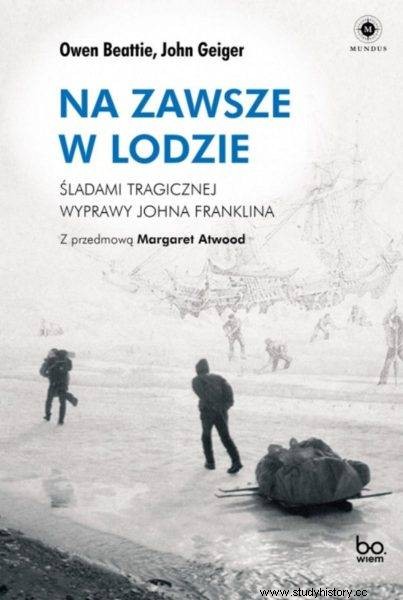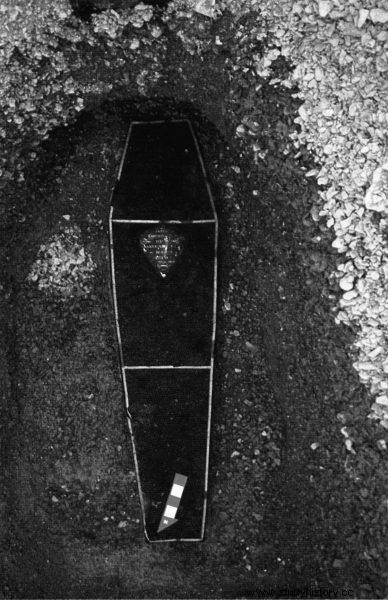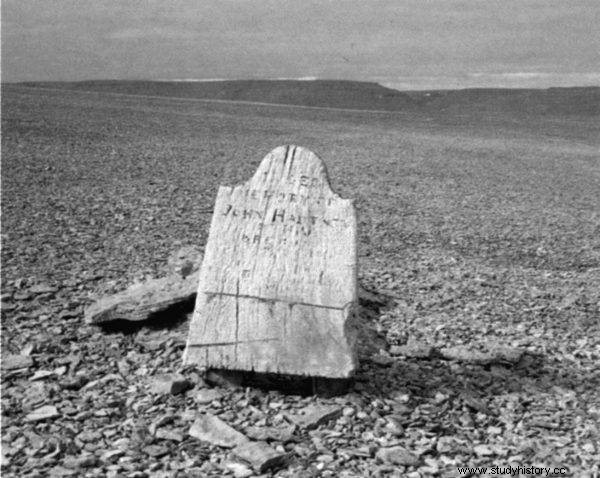When the ships of the British Arctic Expedition under the command of Sir John Franklin, Terror and Erebus, disappeared without a trace, rescue missions to discover the fate of the sailors were followed. Two of them ended tragically ...
Undoubtedly, the harsh Arctic conditions took their toll on the two exploration expeditions funded by the American philanthropist Henry Grinnell.
The first, led by Lieutenant Edwin De Haven of the US Navy, who had two ships under him, Advance and Rescue, set off in May 1850 and was trapped in ice in August and forced to winter in frighteningly low temperatures . Elisha Kent Kane, flight attendant from a wealthy Philadelphia family, described the terrifying conditions the crew had to endure:
Thirty-three heavily dressed men are crowded into a small space smaller than the father's library. One of them is me. Three stoves, a stove in a galley, three lamps burning bear fat burn all the time like in the temple of Vesta.
Damp fur, dirty woolen clothes, worn shoes, sick people, food, tobacco smoke, digestive effects - all of this creates fumes that surround me and penetrate me. Hour after hour, day after day, no bunk to rest on or a blanket curtain to hide behind. It all adds up to the reality of my present home.
"Indefinite hunger" for animal fat
In this atmosphere of depression, the first symptoms of scurvy appear as early as September. As Christmas arrives, many people are short of breath and officers notice a strange phenomenon, previously noticed by British polar explorers, the "indefinite hunger" for animal fat.
Kane describes the "strange waxy pallor" and even "ghastly" faces of the expedition members. People say they have very vivid, bizarre dreams. One says, for example, that he found "Sir Franklin in a beautiful cove lined with orange trees" . Another dreamed that he walked nearby to the empty and lifeless shore of the island and "came back loaded with watermelons."
In January, De Haven also fell ill, who had to resign from his command for this reason. Among other things, he complained of the severe pain of the scar on his hand, the remnants of a teacher's line from a quarter of a century ago.
In February, twelve people were unable to move because their legs were stiff and sore. The supplies of raw potatoes and lime juice to prevent scurvy were running out, and the crew ate mostly salted meat and canned food. In May, a lot of seals and walruses were hunted, which prevented a catastrophe.
Nature's "secret region of terror"
A second expedition, financed by Grinnell, led this time by Elisha Kent Kane, set off in 1853 to officially search for Franklin's lost ships in the Smith Strait, but in fact it was a not very secretive attempt to reach the North Pole .
This was Kane's first self-commanded expedition, and he looked nothing like a seasoned polar explorer. He was a man of frail, even petite stature, but he made up for his physical limitations with the spirit of a fearless adventurer - his account of the expedition is saturated with romanticism.
As he sailed north along the Smith Strait to reach the uncharted basin that bears his name, he thought with delight of the Arctic as nature's "secret region of terror." The crew chose the western shore of Greenland as their wintering site and spent several months of constant torment there.

The text is an excerpt from the book by Owen Beattie and John Geiger “Forever in Ice. In the footsteps of John Franklin's tragic expedition ", Jagiellonian University Publishing House 2021.
About one thing Kane was right. They had to contend with the terror of nature. The ship had no insulation against the cold, and Kane had miscalculated the amount of fuel required, and in February it was not enough to melt ice for washing water. It was so cold inside the Advance ship that one of the crew's tongue was frozen to his chin .
Since their provisions consisted of "ordinary sailor's supplies," most of all pemmican and salted pork, the crew of twenty men developed very severe symptoms of scurvy, which Kane noted carefully. In February 1854 he wrote that "scurvy and general weakness left me breathless".
In April, he and his men set off north, towards the Pole. It was a very risky move that took revenge quickly as the entire team had to turn back soon due to scurvy and frostbite. Kane himself had to be carried, he was "almost insensitive to stimuli and swollen beyond recognition from scurvy." His condition was considered hopeless.
By the time they reached the ship, they were utterly disrupted, distracted, and completely in the grip of disease. They were having suicidal thoughts, gesticulating and talking to each other. The ship "felt like a madhouse." Only three crew members felt well enough to be able to carry out their daily duties. In addition, rats multiplied below deck.
Merciless bragger
Fortunately, with the advent of the summer thaw, the torments of winter subsided. People were sent to hunt, and after the expedition had plenty of fresh meat, they all recovered quickly. However, the ice persisted and the crew had to spend a second Arctic winter.
Under stress, Kane failed in his role as a commander. Everything irritated him, and if he did not get into an argument with one of his officers, he began to brag about his family's status in Philadelphia or his love affairs. He enriched his long monologues during meals with Latin interjections, all for the good of his people, whom he considered to be lower than himself in the social hierarchy .

Coffin with the body of John Torrington. The arrow points to North
The sick and starving crew (when they had a good day they ate the insides of the fox; when they had a bad day they only sucked their gloves) they watched with disbelief and contempt the commander who tried to impress them using an ancient language.
Soon they began to plot behind his back, and in September, seven of them told him that they wanted to abandon the ship and that they would try to reach the town of Upernavik, the northernmost Danish settlement in Greenland, over 1,000 hundred kilometers to the south. But when the rebels set out, they returned to the ship very quickly, freezing cold, and threw themselves at Kane's feet, begging for mercy, which he did not have much for them.
Civilized diet
When the second winter came, they had almost run out of coal, and Kane had the ship's wood burned. They began tearing boards from the deck, chopped the railing and the tops of the masts. Since they had not accumulated enough raw meat in the fall, scurvy attacked them with redoubled force during the winter, causing terrible symptoms. One of the men severed the muscles surrounding the ankle, exposing the tendons and the bone itself.
The only anti-scurvy food they had left in December was peelings and twelve potatoes, which were already three years old. The entire crew was now seriously ill, and Kane was amazed that their health was clearly linked to the availability of fresh meat. This is how he wrote about it:
Our disease is the result of our civilized diet; if we had loads of frozen walrus meat, I'd be laughing on the nose of scurvy.
Later he expressed his admiration about the Inuit:
Our expeditions showed us the wisdom of Inuit appetite, and few of us would now like to eat a slice of seal fat or a piece of frozen walrus meat (...) as nutritious, warming and The food that protects against scurvy is second to none.
Participants on other expeditions looking for Franklin came to the same conclusion, and one of them, the deck physician (on the Lady Franklin and Sophia) Peter Cormac Sutherland, wrote in 1852 that if Franklin wanted to increase his provisions, "no doubt ingenuity would have prompted him, to do what the Eskimos have practiced for thousands of years - preserving animal food, such as whale meat, with ice, which can be easily obtained in summer and stored that way for the winter. "
"I don't have any crew anymore"
Kane himself realized it too late. In the spring of 1855, the health of the crew hit rock bottom and several people died. At one point in the journal Kane writes "my crew", but then corrects himself and adds: "I have no crew left" . From now on he starts calling them "tenants of my bunk".
Indeed, Kane was basically alone by then. Of all the members of the expedition, only he survived the winter in good health. The reason for this was simple. He started eating rats that had infested the ship. His companions, although starving, were not persuaded to follow in his footsteps.

The tomb of 25-year-old John Hartnell
In the spring, the Inuit people of Greenland encountered them and helped them get some fresh walrus meat. Soon after, chilled and soaked, they abandoned their ship and headed south along the coast, first across the ice and then by boat across the water. Eighty-four days later, a Danish ship saw them and they were saved. They had nothing to do with solving the mystery of Franklin's disappearance, because how could they? They were over 1,600 kilometers from where the last traces of the expedition had finally been located.
Source:
The text is an excerpt from the book by Owen Beattie and John Geiger “Forever in Ice. In the footsteps of John Franklin's tragic expedition ", Jagiellonian University Publishing House 2021.
